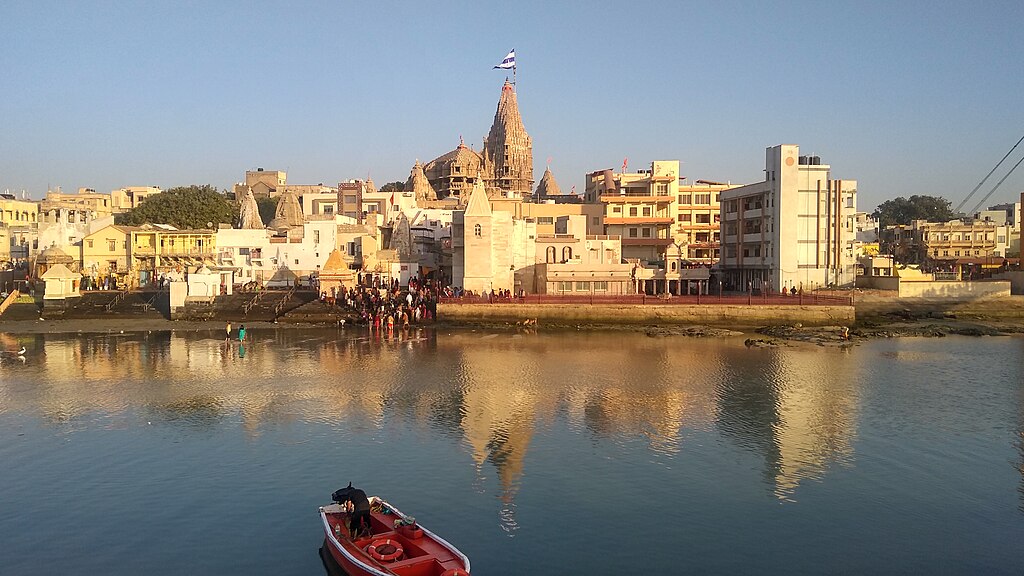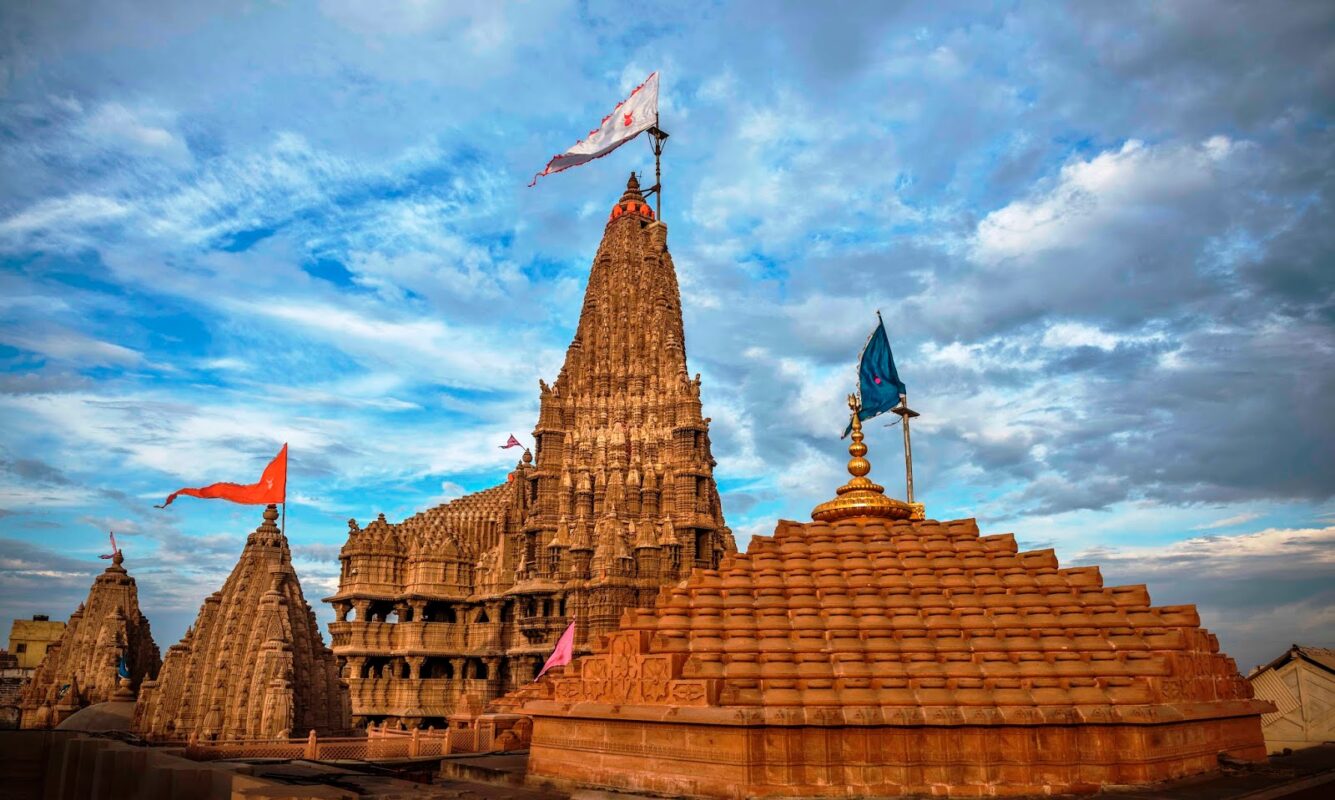Dwarkadhish Temple
Situated in the ancient city of Dwarka, this temple is dedicated to Lord Krishna and is one of the most significant pilgrimage sites in Hinduism. Its rich history and grand architecture reflect centuries of devotion and spiritual significance.

Dwarkadhish Temple: The Divine Legacy of Lord Krishna
| Deity: | Dwarkadhish (Krishna) |
| State – City: | Dwarka, Gujarat |
| Best time to visit | Oct-Mar |
| Open Hours | 7 am–12:30 pm, 5–9 pm |
| Popular festival | Janamashtami |
FAQ
Where is Dwarkadhish Temple located?
Dwarka, Gujarat
What is the history and significance of the Dwarkadhish Temple?
The Dwarkadhish Temple, also known as the Jagat Mandir, has a construction history steeped in ancient legend and historical significance. According to traditional accounts, the original temple was built by Lord Krishna’s great-grandson, Vajranabh, over 2,000 years ago. The existing structure, however, dates back to the 15th-16th centuries when it was rebuilt to its current grandeur. The temple has seen numerous renovations over the centuries, notably under the patronage of the rulers of various South Indian dynasties. Significant contributions came from the Gaekwads of Baroda in the 19th century, who restored and expanded the temple to accommodate the growing number of pilgrims.
What is the architectural style of the Dwarkadhish Temple?
The temple’s construction is characterized by the Chalukya style of architecture, featuring intricate carvings and a towering spire. The five-story edifice is supported by 72 pillars, and the main spire rises to a height of about 78 meters, making it a prominent landmark. The temple’s sanctum houses the idol of Lord Krishna, which is richly adorned with gold and precious stones, symbolizing the deity’s regal and divine presence.
What is the concept of Sapta Puri, and how is Dwarka related to it?
The concept of Sapta Puri represents the seven holiest cities in Hinduism, revered as the most sacred pilgrimage sites. These cities include Ayodhya, Mathura, Haridwar, Varanasi, Kanchipuram, Ujjain, and Dwarka, each deeply rooted in Hindu mythology and religious practices. They are believed to be the abodes of various deities and are associated with the lives and deeds of gods, goddesses, and revered saints. Pilgrimage to these Sapta Puri cities is thought to lead to moksha (liberation) and spiritual fulfillment, making them vital destinations for devout Hindus.
What are some unique points of interest near the Dwarkadhish Temple?
- Gomti Ghat: The temple is located at the confluence of the Gomti River and the Arabian Sea. The Gomti Ghat, where pilgrims take a holy dip, is an important part of the pilgrimage.
- Dwarka Lighthouse: Near the temple, the Dwarka Lighthouse offers a panoramic view of the Arabian Sea and is a popular spot for visitors.
- Bet Dwarka: Bet Dwarka, also known as Shankhodhar, is an island located approximately 30 km from Dwarka, accessible by a brief boat ride from Okha. It holds immense significance as it is believed to be the original residence of Lord Krishna and his family. The island is mentioned in ancient texts and is considered a sacred site where Lord Krishna lived with Rukmini.
What is the significance of the ancient city of Dwarka in Hindu mythology?
The Dwarkadhish Temple is intrinsically linked to the ancient city of Dwarka, which, according to Hindu mythology, was established by Lord Krishna after he left Mathura. This city is believed to have been a magnificent and prosperous kingdom that eventually submerged underwater. Archaeological explorations have discovered remnants of what is considered the ancient city of Dwarka off the coast of present-day Dwarka in Gujarat, adding a layer of historical intrigue to the mythological narratives. The submerged ruins suggest that Dwarka was a well-planned city with advanced urban infrastructure. The modern Dwarka, where the Dwarkadhish Temple stands, is revered as the site where Lord Krishna ruled and performed various divine acts, thus maintaining a deep spiritual and historical connection to the legendary sunken city.
How can one reach the Dwarkadhish Temple?
The Dwarkadhish Temple in Gujarat can be reached by various means:
- By Air: The nearest airport is Porbandar Airport, located about 105 km from Dwarka. Another nearby airport is Jamnagar Airport, about 137 km away.
- By Train: Dwarka Railway Station is well-connected to major cities like Mumbai, Ahmedabad, and other parts of Gujarat.
- By Road: Dwarka is well-connected by road. State transport buses and private taxis are available from major cities in Gujarat.
What are some unique architectural features of the Dwarkadhish Temple?
The Dwarkadhish Temple boasts several unique architectural features:
- The five-story structure is supported by 72 pillars.
- The main spire rises to a height of about 78 meters (256 feet).
- The temple is adorned with a large flag, known as the “Dwaja” or “Pataka,” which is changed three times a day. The flag is a significant symbol of the temple and is visible from a considerable distance, signaling the temple’s presence to devotees and visitors.
When is the best time to visit the Dwarkadhish Temple?
- Season: The best time to visit Dwarkadhish Temple is from October to March when the weather is pleasant.
- Festivals: The most significant festival is Janmashtami, celebrated in August or September. Other important festivals include Holi, Diwali, and the annual Dwarka festival.
The Dwarkadhish Temple stands as a testament to the divine legacy of Lord Krishna and the rich cultural heritage of India. With its ancient history, stunning architecture, and deep spiritual significance, it remains a beacon of devotion and a must-visit destination for pilgrims and travelers alike. May your visit to Dwarka bring you closer to the divine and enrich your spiritual journey.







